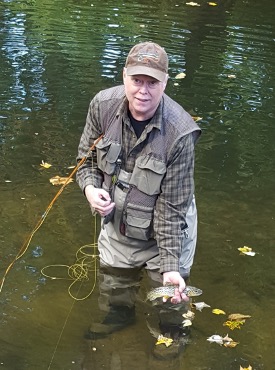By Kevin Haney

Being 100 years behind the times can sometimes be challenging. Today, a lot of fly fisherman will look at you suspiciously if you don’t use the latest and greatest space age rod straight from the laboratory. Anything that weighs more than a postage stamp they irreverently call a “club.” They may even think you are a little off in the head if you usually hit the stream with an antique rod in hand. It has been said, with the usual amount of veracity that such sayings contain, that most fisherman think that fly fisherman are a little nuts and that most fly fisherman think that bamboo rod aficionados are a little nuts. Well, if you fish wood rods, even the bamboo nuts think you are nuts. Be that as it may, I started my fly fishing journey this spring with a few nice greenheart rods from across the pond, as they are a lot more numerous and inexpensive than American wood rods. Besides being taken by their beauty and simplicity, their very slow casting rhythm fits in with my Zen aspirations to slow down in all things. Casting a quality 120 year old greenheart or lancewood rod with a fine silk fly line is an experience that every fly fisherman should have at least once.
Bowing to peer pressure, however, I finally decided to try one of those new-fangled fly rods made from glued up strips of bamboo that I’d heard about. They seem to generate such passion amongst their devotees that they must have something going for them. After looking around a bit, I bought an old South Bend #323 8 ½’ bamboo rod and paired it with a 1930s vintage Pflueger Gem reel and a 5 wt line. After a lot of lawn casting, I finally felt confident enough to try it on the water. All I needed was a good guide to put me on some trout. I had seen Mike Heck’s presentation on Pennsylvania trout streams at our last non-virtual club meeting in March, so I contacted him and arranged for an early October outing on one of his favorite streams near Chambersburg, the Conococheague.
Arriving at the arranged meeting place, I explained to Mike that I was a rank beginner and that I would be looking to him for advice on all areas of trout fishing. Luckily for me, it turned out that one of his strengths as a guide is his ability to patiently teach beginners the basics. The Conococheague is a pretty little urban freestone trout stream that is very accessible. We drove to a sweet little pool on the river and saw a number of trout rising. These, Mike explained, were holdover fish from the spring stocking. After suiting up, he suggested that I use a dry dropper setup and suggested a tan caddis for the dry fly and a Mike Heck bead head caddis nymph for the dropper. After cautiously wading out, making a few casts and having a couple of trout roll on my fly, a nice brown trout swirled and inhaled the dropper. I quickly set the hook and then, after a short fight, had landed my first trout on bamboo! I will probably always remember that fish, even though it was only about a foot long. He was quickly released and allowed to rejoin his cohorts. Since the rest of the pool was put down by all of the commotion, we tried a couple of other places upstream. While we did see more trout, those trout weren’t eating, although unfortunately the baby creek chub were.
We tried a couple of other spots along the Conococheague but didn’t have any luck as there wasn’t anything hatching at the time. Mike suggested we go back to the original pool in which I’d caught the trout earlier in the day and me being game, we did so. There were still a good number of trout that could be seen feeding along a current seam. Mike pointed out a nice one and I cast a little upstream of it. It was only a few seconds later that I was rewarded by the strike of a very nice brown trout, a couple inches larger than the one I’d caught earlier. After that, the trout seemed to have decided that it wasn’t a particularly good life choice to eat things with hooks in them anymore, so we called it a day.
For my first experience with a professional guide, Mike set a high bar for the future. In addition to being very knowledgeable in the local hot spots, stream entomology, fly tying and all things fly fishing, he helped me feel more confident to pursue my fly fishing journey. And with probably the best rates around, I can highly recommend his services to trout anglers of any experience level if you want to explore some of the pretty trout havens in southern Pennsylvania.
I hope to be able to go out with Mike again before winter sets in. I’ve heard through the fisherman’s grapevine that there is a new wonder material, called fiberglass I think, that will completely replace bamboo very soon. Maybe I’ll have to give it a try. But then again, riding the wave of technological progress is very tiring for someone my age, so maybe I won’t.
Mike Heck can be contacted via his web site at fallingsprings.com.
You must be logged in to post a comment.